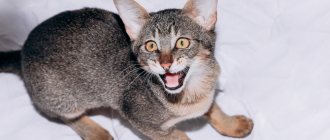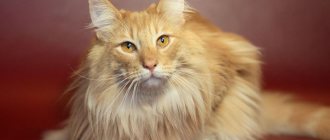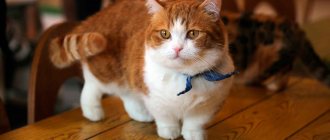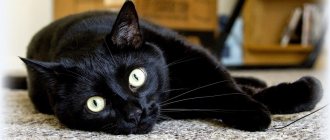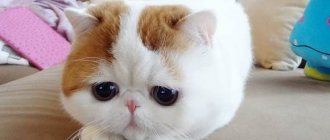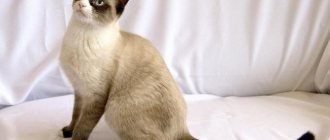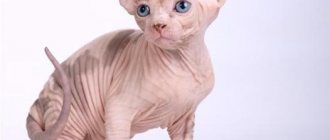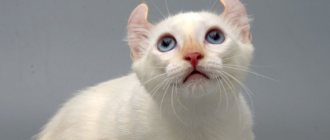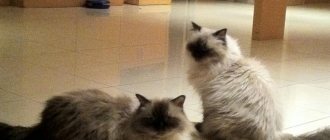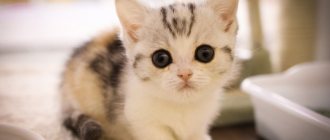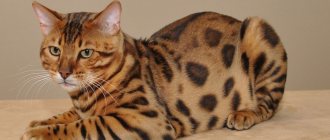| Origin | Türkiye |
| Wool | semi-long |
| Dimensions | weight 4-9 kg, height 35-40 cm at the withers |
| Lifespan | 15-17 years old |
The Van cat or Turkish van is a rare case - the variety has an aboriginal origin and an ancient history. For thousands of years, these animals interbred naturally, becoming the natural basis for most modern breeds. The name of the cats is associated with their homeland - a section of the Armenian Highlands near Lake Van. The species is characterized by excellent health, a stable phenotype and a gentle cat disposition.
Origin story
Agile shaggy cats - “vana katu” - were first seen near Lake Van: this body of water was considered part of ancient Armenia, and later passed to the Ottomans.
A Turkish legend says: when the devil decided to destroy Noah's ark, he threw a mouse into it so that it would gnaw a hole in its walls. But God, wanting to save humanity, sent her white cat to be destroyed. The furry huntress successfully completed her job, and as a reward, God touched her with his hand. The red marks on her fur are called God's tracks.
Merchants and crusaders exported cats to other continents. They did not gain much popularity there, but received a new name - ring-tailed cats. They became the ancestors of the modern Turkish Vans.
In the 50s, British journalist Laura Lushington took a pair of unusually beautiful kittens: a male and a female, from Turkish territory. They gave birth, and by 1994 these cats were recognized by most major cat fancier organizations. The name "Turkish cat" was changed to "Turkish van".
Turkey, which for a long time refused to recognize the uniqueness of its charges, eventually radically changed the principle, introduced a ban on the export of cats and declared them a national treasure. It is worth saying that only cats with heterochromia and snow-white fur deserve such a reverent attitude. But felinological organizations treat them in two ways.
Defects of the Van breed
Since the Turkish Van cat breed was formed in a natural environment, its representatives rarely suffer from hereditary pathologies leading to disqualification. Kittens, in most cases, are born healthy.
Defects of appearance include disturbances in Van coloration and pathologies of skeletal bones. Let's take a closer look.
Tendency to diseases
By nature, Turkish Vans are active and lively cats. Lethargy and apathy of a pet is a clear sign of poor health and health problems. The most commonly diagnosed hereditary pathologies are:
- hypertrophic cardiomyopathy;
- diseases of the teeth and oral cavity;
- urolithiasis;
- allergic reactions;
- thromboembolism affecting the hind limbs.
In addition, pets experiencing a lack of physical activity have a tendency to gain weight. In this case, the duration of walks is increased and the cats are transferred to a special medicinal diet.
Defects in appearance
The most common appearance disorder among Turkish Vans is a pronounced stop (a sharp line of transition from the forehead to the bridge of the nose). There are also various disorders of the skeletal bones: broken tail, sunken chest, underdevelopment of the phalanges of the fingers.
There are also color defects. Experts say that Van coloring (regularly shaped ear markings and a colored tail) guarantees the purity of the breed. A white cat must have at least one parent of the Van color. The probability of mutations in white offspring obtained by crossing white parents increases sharply. Most often, these are various hearing impairments, up to complete deafness. In addition, cats whose white coat area is less than 85% are subject to disqualification.
How long does a Turkish Van live?
On average, Van breed cats live 15-17 years. In the absence of stress, good care, and high health potential, the lifespan can be 18-20 years.
Standards
Cats of this breed cannot be called miniature: the average weight of the animal is 6-9 kg. Moreover, males are outwardly larger and more massive than females.
| Standard | Description |
| Scull | Wedge-shaped, with minimal muzzle definition and a clearly defined chin. |
| Ears | Large, with a wide base and rounded tips. Both inside and outside the auricle is densely pubescent. |
| Nose | Small, the tip is colored soft pink. |
| Eyes | Large, open, slightly elongated. The color of the iris is blue or dark yellow. Different colored eyes are not considered a defect. |
| Torso | Small but strong, with a well-developed muscular corset, massive chest and strong neck. |
| Knees | Medium length, paws rounded, small. The pads are pale pink. |
| Tail | Reminiscent of a brush: covered with semi-long, thin hair. In summer the pubescence is quite sparse, but in winter it looks much more impressive and resembles a luxurious fan. |
| Wool | The undercoat is completely absent, and the coat itself is silky to the touch, semi-long. Longer on the hips and tail, shorter in the neck and shoulders. Summer cat “clothes” are light and airy, winter ones are heavier and thicker. |
These signs lead to disqualification:
- a clear “stop” on the bridge of the nose,
- no spots on the head,
- too many colored marks (more than 15% on the entire body),
- flat chest, underdeveloped fingers,
- creases and loops on the tail.
The cost of individuals of this breed is high, since this breed is rare. There is only one nursery in Russia, the rest are only abroad (in Canada, Turkey, USA). The price for 1 kitten ranges from 50,000 to 100,000 rubles. It is dangerous to buy animals from private breeders: you can run into unscrupulous sellers.
Description of the Van cat
The main distinguishing feature of the Turkish Van is the characteristic Van color, in which the main part of the body (at least 80%) is snow-white, and the tail and markings on the head are the color of “Armenian apricot” or the sunrise and sunset on Lake Van. Some felinological associations today also recognize completely white cats, considering them mestizos obtained as a result of crossing with an Angora cat.
Spending their lives on the shore of a reservoir, Van cats learned to swim and fish beautifully. And the unstable climate of the Armenian Highlands determined the special qualities of the coat. Turkish Vans have long and light outer hair that protects them in both cold and heat. Seasonal changes in length and density provide excellent thermoregulation.
Appearance of a cat
The Turkish Van is a large breed. Thanks to their luxurious wool, they visually look even larger. Cats have a strong body with a developed chest and powerful legs. Height at the withers reaches 40 cm, and weight can exceed 9-10 kg. The length of large cats (including the tail) is 120-130 cm. Turkish Vans have pronounced dimorphism, so the cats look smaller and more graceful.
The rear, pushing legs of cats are slightly longer than the front ones. The large, webbed paw pads (as well as the nose) are pink. Tufts of thick fur grow between the toes, softening the steps.
The head of the Vanir is shaped like a blunt wedge. The features of the muzzle are clearly expressed: a strong chin and cheekbones, a straight bridge of the nose, a soft line of transition from the forehead to the nose, a small pink lobe.
The ears are medium in size, set quite wide (at a distance of about three fingers). These are triangles with a rounded tip (without tassels). The auricle is densely pubescent both outside and inside.
The eyes are shaped like large almonds and are slightly slanted. The color of the iris in most cases is amber or blue, but heterochromia (divergence of eyes) is also allowed.
The medium tail, due to its thick fur, has the shape of a kitchen brush. When Vans molt, it remains thick and looks particularly rich in contrast to its shrunken body.
Van cats are a semi-long-haired breed. Thick hair (up to 5 cm) without undercoat allowed the cats to successfully adapt to the difficult climate of the Armenian Highlands.
Colors
Most Vans have the classic shade of color markings - red-chestnut. Cream, red, black, blue, tabby, tortoiseshell, and torby (spotted tabby) colors are also allowed. White patches on the tip of the tail, colored spots in the leg area and on the left shoulder are acceptable.
The appearance of bicolor or paticolour tones, as well as the ratio of white to colored areas below 75% are a violation.
Character of the breed
The Turkish Van is an active and sociable dog, an ideal home companion. He is very active and curious, but is a one-owner cat (he tends to distinguish his person from other family members). These cats are not intravenous. They strive to attract attention, are eager for approval from people and do not like to be alone.
Turkish Vans are jealous. In relationships with other pets they will strive for dominance. They play with children with pleasure, but when trying to be familiar, they can release their claws.
But most of all, Van enjoys spending time with his beloved owner. He loves to sit on his shoulders and also loves outdoor games. But Van prefers splashing around in a bath with warm water to all games. After all, baths are one of the few breeds for which water is their usual habitat.
The Turkish Van is very emotional. He likes to express his feelings not only with sounds, but also with rich facial expressions. He is an excellent hunter, mouser and flycatcher.
Colors
Classic color: white coat with ring-shaped prints on the tail and markings on the shoulder blades and between the ears. The markings on the head are colored cream, red, blue or black. Tabby marks are also common. The most common colors are blue, cream, brown and red. There are Turkish Vans with torbi spots (including diluted ones) and tortoiseshell.
In the photo there are cats of the Turkish Van breed of popular colors
It happens that paticolor and bicolor babies are born, the percentage of white wool in which takes up half or more of the total wool. Experts do not like this kind of outcrossing (adding blood from another breed).
How to choose a kitten
Rare Van cats, photos of which can be seen on the Internet, are not available for free purchase. Under no circumstances should you trust private advertisements or offers to buy a van without documents. First, you will have to reserve the baby from an official breeder who is registered with the international felinological club.
Do not forget that a kitten, even in its native Turkish nursery, must be healthy and also correspond to the description of the breed.
When choosing a pet you should consider:
- breeder's reputation;
- availability of a veterinary passport;
- purity of pedigree;
- baby's appearance.
To be able to assess the development and condition of Van, the kitten should not be younger than 3 months. The animal must eat independently, have a well-fed, strong body, and behave actively and inquisitively.
Character and behavior
If the Turkish van wants entertainment, neither your sidelong glances nor the limited space will interfere with him. At the same time, the cat will try to attract everyone nearby to the game, offering a toy to you, your dog, and the parrot in the cage. The Vans will not climb onto the highest cabinet and throw a couple of obviously unnecessary souvenirs off the shelf, and then sit down and watch the surrounding commotion.
These cats simply love to swim. As they say, don’t feed him bread, let him swim to his heart’s content. Therefore, any trickle of water and any container with life-giving moisture arouses his genuine interest.
And if there are fish in the pond, turn off the lights. The Turkish van will not rest until he catches every single one. So keep a close eye on your aquariums.
Turkish Vans are not intrusive, but will always hang out somewhere next to a person with a proud and independent appearance, but with a clear bit of curiosity. These are true leaders and completely independent individuals, so they and only they will decide: when to go eat, when to sleep, and when to allow themselves to be showered with a portion of affection. Moreover, it is cats who are more stubborn in this matter, while cats are more docile and relaxed. In cat families, the main ones are always females.
There are no authorities for Van, so be prepared for confrontation. Naturally, you need to start raising a kitten literally from the first days, when he begins to more or less think, however, if something gets into his head, he will defend his position to the bitter end. The cat will definitely have a favorite, but the furry “king” will try to lead them.
According to folk wisdom, what should happen if a cat washes itself?
Receive a letter Guests will come
They have excellent memory, which allows them to build cause-and-effect relationships and calculate the situation in advance. It is useless to beat them, as well as to raise your voice: they will be offended and, possibly, take revenge. A punishment that will work: deprivation of tasty food and your communication.
Interesting facts about the Turkish Van breed
- Turkish Van wool has unique dust-repellent and water-repellent properties. In addition, it is softer than fluffy cashmere yarn.
- Many owners note that the Vanir’s favorite game is catching streams of water from a slightly open tap. On a hot summer day, they will be happy to stand under a cool stream, and at night they will go to sleep in a damp sink
- A monotonous life within four walls is unacceptable for these cats. They love walks, travel, new experiences. The owner will have to often play with the cat and replace his torn and tired toys.
Van cat in literature and fine arts
Van cats are a cultural symbol of the Armenian, Turkish and Kurdish peoples - those who inhabited the coast of Lake Van in different periods of time. Images of these animals can still be found on the products of Armenian craftsmen (carpets, dishes, clothes). Mention of them is present in works, films and paintings:
- Ancient Armenian work “The Birth of Vahagn”.
- Axel Bakunts, story “In a Dark Gorge” (1927).
- Vrtanes Papazyan, story “Vana Katu”.
- Hakob Melika-Hakopyan, novel “Diary of the Cross Thief” (1890).
- Roger Tabor, documentary "Cats" (1999).
- Antoine Jean Bayle, French artist, painting “Girl with a White Cat” (late 18th-early 19th centuries).
In the Turkish (and formerly Armenian) city of Van, a monument dedicated to van kedesi, a snow-white cat with different eyes, was erected.
Care instructions
Turkish vans are very clean. They demand from the owner a perfectly clean tray, after each visit to the toilet they will bury their excrement for a long time and diligently, and dissatisfiedly move the bowl of dirty water. If the owner turns out to be slow-witted and does not correct the situation in time, he will find a cleaner corner for the toilet, and stick his nose into the toilet in search of clean water.
Wool
To keep your pet looking neat, the grooming schedule should be as follows: brush it once a week with a classic brush with natural bristles, starting from the head.
Bathing - no more than once every 4 months. Despite the Vanir’s love of bathing, frequent water procedures do not benefit them: the protective layer is washed off from the body, which can provoke all sorts of inflammation.
Ears
The ears are examined once every 2 weeks: have ear mites settled inside? Has a sulfur plug formed? Contaminants are removed with a cotton swab soaked in ear lotion or hydrogen peroxide.
Teeth
The Vanir's eyes do not cause concern, but they will have to take special care of their teeth: they deteriorate quickly in cats and are difficult to treat. If your cat refuses to brush its teeth, take it to the dentist for ultrasonic teeth cleaning, and add a special cleaning gel to the water.
Claws
Vans successfully use a scratching post to shorten claws, but if you notice that your cat is being lazy, trim the claws yourself. You can buy a special nail clipper, or you can use regular manicure scissors.
In the photo, a Turkish Van cat is fishing
Advantages and disadvantages
The Turkish Van cat has many positive qualities:
- special wool with a soft texture, lack of undercoat and unique properties;
- high intelligence and learning abilities;
- quick adaptation to conditions of detention;
- good health with natural immunity.
Along with its advantages, the van has some disadvantages:
- high cost due to the rarity of the breed and the difficulty of exporting from Turkey;
- there is a high chance of encountering scammers when searching for a kitten;
- the dominant character of the Van;
- the need to pay a lot of attention and spend time playing with the pet;
- mandatory bathing and dental care.
Catering
Natural products
Natural food is good because you can always buy fresh food and, from time to time, pamper your pet with new cereals or cutlets.
From natural products it is allowed to give:
- lean boneless meat (beef, veal, chicken, lamb and turkey);
- fish (flounder, trout, salmon, navaga);
- fermented milk products (cottage cheese, yogurt, sour cream, cream, fermented baked milk, natural yogurt);
- porridge (rice, millet, semolina, buckwheat, oatmeal);
- stewed or boiled vegetables (pumpkin, zucchini, carrots, asparagus, broccoli, cucumbers);
- fruits (melon, apple, pear, watermelon).
You should not feed your Turkish Van food that is fatty, fried, smoked, salty or sweet. Seasonings, pickled vegetables, flour, baked goods, many vegetables (potatoes, tomatoes, peas, eggplants) and fruits are prohibited!
Recommended food
Breeders from the USA and Canada strongly recommend feeding Vans with high-quality ready-made food. These include holistic and super-premium food. These are expensive, but high-quality feeds made from high quality products.
Contains: dehydrated meat and fish, dried berries, fruits and vegetables, a good vitamin and mineral complex has been added. Examples of holistic foods: Nutram, Carnilove, Farmina N&D. Super-premium food: ProSeries, Fitmin For Life.
Economy food classes: Whiskas, Nasha Marka, TerraKot and premium are lower in quality and are not worth buying without unnecessary need.
Below are recommended super-premium foods. Links with the names of the food are clickable, on them you can, within our website, get acquainted with the descriptions of the food and read reviews from owners of Turkish Van cats.
| Holistic | Super premium | Super premium |
| Primordial | Guabi Natural | 1st Choice |
Turkish Vans are prone to obesity, so do not overfeed the animal and do not teach it to snack between meals.
You can only drink clean filtered water. It can be settled, bought distilled, or purified using a kitchen filter.
Peculiarities
This breed is also sometimes called the Turkish Van water cat. This is explained simply. Among the purring four-legged animals, you don’t often meet those who are calm about water.
Vans love to swim. The structure of their coat helps them to tolerate contact with water calmly. The cashmere-feel of the wool is actually water-repellent.
Diseases
Since the Turkish Van is an aboriginal breed, they have fewer genetic pathologies than hybrid breeds. However, health problems still arise. Let's list the main ones:
Hypertrophic cardiomyopathy is an insidious disease that, unfortunately, cannot be completely cured, but can be “suppressed” and alleviate the pet’s general condition. It is expressed in thickening of the left cardiac ventricle and the septum between the ventricles (while the ventricular cavity itself is greatly reduced).
The disease occurs more often in males: the animal becomes more lethargic, suffers from shortness of breath, tachycardia, breathes heavily, and a murmur is heard in its heart. Pulmonary edema gradually increases, fluid accumulates in them, pressure increases, and partial paralysis occurs. The cough is completely absent. Catalyst: prolonged stress, illness, infusion therapy carried out without proper calculations of the speed and volume of fluid. Treatment is medication; in severe cases, it occurs in a hospital.
The weakest point of the Turkish Van is the gums and teeth. The gums often become inflamed, and tartar builds up on the teeth. Other diseases also appear. Therefore, it is important for you to monitor this from the very beginning: choose the right care products, brush your teeth regularly, and regularly take your animal for examination to the veterinarian.
Expert opinion
Dusheba Vera Ivanovna
In 2010, she graduated from the Moscow State Academy of Veterinary Medicine named after K.I. Scriabin with honors, specializing in veterinary medicine. I regularly attend veterinary conferences, congresses, and webinars.
Do not refuse vaccination, even if your cat is indoors and, in your opinion, is completely protected. This is not true: pathogens of such dangerous diseases as panleukopenia, rhinotracheitis and others easily enter your home on clothes or hands.
Health
The Van breed has good health, thanks to its natural origin and long-term free crossing. Turkish cats are not prone to any diseases that are unique to them. Like all cats, Vans are often born with hypertrophic cardiomyopathy, which is characterized by symptoms such as lethargy, shortness of breath, and apathy. The disease has no cure, only supportive therapy.
Due to genetic characteristics, it is not recommended to cross two animals of pure snow-white color. This significantly increases the risk of producing kittens with hereditary deafness.
The dominant allele of the white coat genes affects the formation of the inner ear and causes a mutation in the early stages of embryonic development. If at least one van in a pair has a colored color, then the chance of having deaf kittens is significantly reduced.
The Turkish cat is characterized by a high level of immunity, rarely catches colds and is able to cope with simple viruses on its own. And to prevent dangerous diseases, it is enough to follow the vaccination regime and carry out deworming in a timely manner.
Poor nutrition or improper care can cause:
- allergies;
- hormonal imbalance;
- gingivitis;
- arterial thromboembolism;
- urolithiasis.
If you give your pet proper attention and care, the van will live at least 15 years.
Photo gallery
Below are photos of Turkish Van cats.
What is the price
Turkish Van kittens are so rare in Russia that they are highly valued. An animal with a full set of documents will not cost less than 20 thousand rubles. The absence of a metric most often indicates a mestizo or a completely outbred cat.
The price of a high-quality cat with a good pedigree, brought from abroad, will be even higher - 30-100 thousand. When buying a van in Turkey, it is worth considering that in order to export a kitten you will have to obtain a special permit. In addition to its native country, the breed is bred in the USA, Germany and the Netherlands.
